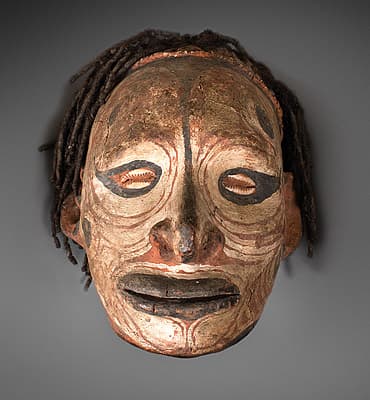
Papua New Guinea, East Sepik Province
Overmodelled skull 19th early 20th Century prior to 1917 overmodelled skull , Skull, shell, clay, ochres, hair24.0 (h) x 20.0 (w) x 24.0 (d) cm South Australian Museum
The over modelling of the skulls of men, women and children was once a common practice for both the Iatmul and the Sawos people. These decorated skulls were often of identifiable ancestors rather than those taken in headhunting raids as trophies, although both could receive similar treatment.
They were kept by families of the deceased and were also displayed in the ngeko ceremonial house. Being in the presence of your ancestors in such a physical form was important for the ceremonial events of initiation, marriage, and the preparation and celebration of headhunting. The overmodelled skulls could be placed at specially constructed openings in the façade of the haus tambaran where they would gaze down on events unfolding on the performance ground and also keep watch against enemy headhunting parties.
The overmodelled skulls were excellent form of portraiture—the hair of the deceased or related mourners was used and the facial proportions would be measured to give as much of a likeness as possible.
The over modelling of the skulls of men, women and children was once a common practice for both the Iatmul and the Sawos people. These decorated skulls were often of identifiable ancestors rather than those taken in headhunting raids as trophies, although both could receive similar treatment.
They were kept by families of the deceased and were also displayed in the ngeko ceremonial house. Being in the presence of your ancestors in such a physical form was important for the ceremonial events of initiation, marriage, and the preparation and celebration of headhunting. The overmodelled skulls could be placed at specially constructed openings in the façade of the haus tambaran where they would gaze down on events unfolding on the performance ground and also keep watch against enemy headhunting parties.
The overmodelled skulls were excellent form of portraiture—the hair of the deceased or related mourners was used and the facial proportions would be measured to give as much of a likeness as possible.
The over modelling of the skulls of men, women and children was once a common practice for both the Iatmul and the Sawos people. These decorated skulls were often of identifiable ancestors rather than those taken in headhunting raids as trophies, although both could receive similar treatment.
They were kept by families of the deceased and were also displayed in the ngeko ceremonial house. Being in the presence of your ancestors in such a physical form was important for the ceremonial events of initiation, marriage, and the preparation and celebration of headhunting. The overmodelled skulls could be placed at specially constructed openings in the façade of the haus tambaran where they would gaze down on events unfolding on the performance ground and also keep watch against enemy headhunting parties.
The overmodelled skulls were excellent form of portraiture—the hair of the deceased or related mourners was used and the facial proportions would be measured to give as much of a likeness as possible.
